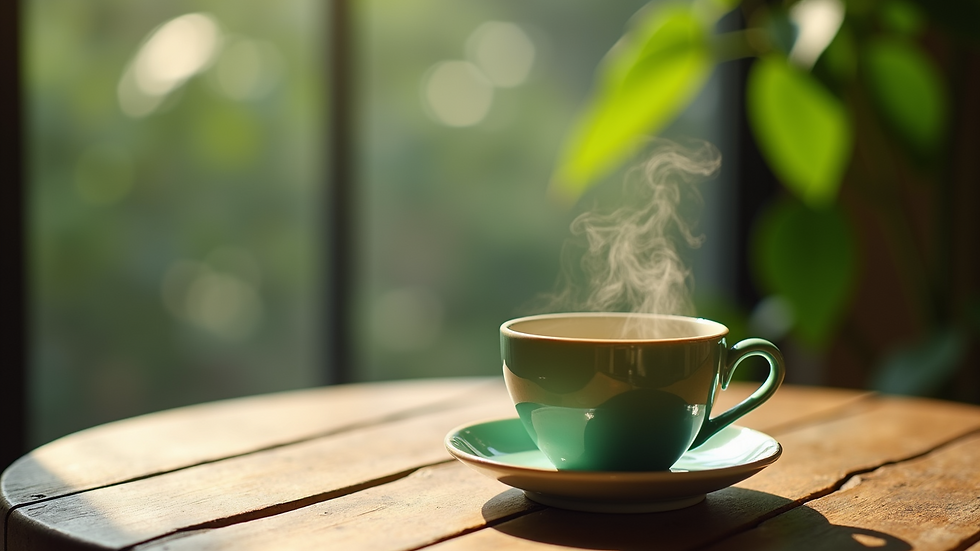Mastering the Art of Tea Exploration
- A Steep In Time
- Oct 20
- 3 min read
Tea is more than just a beverage; it is a journey of flavors, aromas, and traditions. Whether you are a casual drinker or an aspiring connoisseur, understanding the basics of tea tasting can elevate your appreciation and enjoyment. This guide will walk you through the essential steps and knowledge needed to master the art of tea tasting and embark on a delightful tea exploration.
Understanding the Basics of Tea Tasting
Tea tasting is a sensory experience that involves evaluating the appearance, aroma, flavor, and mouthfeel of tea. To begin, you need to prepare your tea properly:
Use fresh, filtered water heated to the right temperature (usually between 160°F and 212°F depending on the tea type).
Measure the correct amount of tea leaves (generally 1 teaspoon per 8 ounces of water).
Steep for the recommended time (from 1 to 5 minutes depending on the tea).
Once brewed, observe the tea’s color and clarity. A bright, clear liquor often indicates quality. Next, inhale the aroma deeply to detect floral, fruity, earthy, or smoky notes. When tasting, take a small sip and let the tea coat your palate. Notice the balance of bitterness, sweetness, and astringency. Finally, pay attention to the aftertaste or "finish," which can linger pleasantly or fade quickly.
Tips for Effective Tea Tasting
Use a clean, neutral cup or tasting bowl.
Avoid strong perfumes or foods before tasting.
Take notes on each tea’s characteristics.
Compare different teas side by side to sharpen your palate.

Exploring Different Types of Tea
Tea comes in many varieties, each with unique processing methods and flavor profiles. The main categories include:
Green Tea - Leaves are quickly steamed or pan-fired to prevent oxidation, resulting in fresh, grassy flavors.
Black Tea - Fully oxidized leaves produce bold, robust, and sometimes malty or fruity notes.
Oolong Tea - Partially oxidized, offering a balance between green and black tea characteristics with floral or creamy undertones.
White Tea - Minimally processed, delicate, and subtly sweet.
Pu-erh Tea - Fermented and aged, known for earthy and rich flavors.
Each type requires specific brewing techniques to bring out its best qualities. For example, green tea benefits from lower temperatures and shorter steeping times, while black tea can handle boiling water and longer infusions.
How to Taste Different Teas
For green and white teas, focus on light, fresh, and floral notes.
For black and pu-erh teas, look for depth, complexity, and richness.
Oolong teas often reveal multiple layers of flavor as they cool.
Experimenting with these teas will deepen your understanding and appreciation of their diversity.

Which Country is No. 1 in Tea?
When it comes to tea production and consumption, China holds the top spot globally. China is the birthplace of tea and produces the widest range of tea types, including green, black, white, oolong, and pu-erh. The country’s diverse climates and regions contribute to the unique flavors and qualities of its teas.
India follows closely, famous for its robust black teas like Assam and Darjeeling. Sri Lanka (Ceylon tea) and Japan (notably green teas like matcha and sencha) are also major players in the tea world.
Why China Leads in Tea
Historical significance: Tea culture dates back thousands of years.
Varied terroirs: Different provinces produce distinct teas.
Innovative processing: Traditional and modern techniques coexist.
Large domestic market: High consumption fuels quality and variety.
Understanding the origins of tea enhances your tasting experience by connecting flavors to their cultural and geographical roots.

Practical Tips for Enhancing Your Tea Experience
Mastering tea tasting is not just about the tea itself but also about the environment and mindset. Here are some actionable recommendations:
Create a dedicated tea space: A quiet, clean area free from distractions.
Use quality tools: Invest in a good teapot, kettle, and cups.
Keep a tea journal: Record your impressions, brewing parameters, and favorite teas.
Pair tea with food: Try mild cheeses, fruits, or light pastries to complement flavors.
Join tea communities: Online forums or local tea clubs can offer support and new discoveries.
By incorporating these habits, you will develop a more refined palate and a deeper connection to tea.
Embracing the Journey of Tea Exploration
Tea is a world of endless discovery. Whether you prefer a simple cup of black tea or an elaborate tasting session, the key is to remain curious and open-minded. Engaging in tea exploration allows you to appreciate the subtle nuances and cultural richness behind every sip.
Remember, tea tasting is a personal experience. There is no right or wrong way to enjoy it. The more you practice, the more you will uncover the stories and sensations hidden in your cup.
Start your journey today and savor the art of tea in all its forms. Happy tasting!




Comments